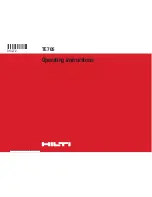
3
•
to another.
Shorting the battery terminals together
•
•
SERVICE
•
Under abusive conditions, liquid may be ejected
from the battery; avoid contact. If contact ac-
cidentally occurs, flush with water. If liquid
contacts eyes, additionally seek medical help.
Liquid ejected from the battery may cause irritation
or burns.
Do not use a battery pack or tool that is dam-
explosion or risk of injury.
•
• Follow all charging instructions and do not charge
the battery pack or tool outside the temperature
Charging im-
SPECIFIC SAFETY RULES FOR
PRESS TOOL
should operate tool.
repair person using only identical replacement
parts.
This will ensure that the safety of the power
tool is maintained.
Never service damaged battery packs.
Service
of battery packs should only be performed by the
manufacturer or authorised service providers.
Fingers could be crushed.
• Do not use tool without press jaw installed.
• Use tool only as directed. Only trained personnel
in use.
Fingers could be crushed.
• Keep hands away from press jaw while tool is
•
• Chemical Burn Hazard. Keep coin cell battery
away from children.
•
•
•
To reduce the risk of injury, wear safety goggles
or glasses with side shields. Inspect and discard
workpieces with cracks or wear before use.
Materials may crack or shatter.
•
Only use press jaw with a compression range
rated for this tool.
• lead from lead-based paint
• crystalline silica from bricks and cement and other
masonry products, and
WARNING
sawing, grinding,
Some dust created by power sanding,
drilling, and other
construction activities contains chemicals known to
cause cancer, birth defects or other reproductive
harm. Some examples of these chemicals are:
SYMBOLOGY
Volts
Direct Current
W
Watts
• arsenic and chromium from chemically-treated
lumber.
Read operator’s manual
Risk of Injury
SPECIFICATIONS
Cat. No. ...................................... M18 ONEBLHPT
Volts........................................................... 18V DC
Watts .................................................................450
Compression Range
Nominal Force ................................................ 32kN
Using Ring ............................... < Ø 4" (100 mm)
Using Jaws .............................. < Ø 2" (50 mm)
Battery Type .................................................M18™
Recommended Ambient
Charger Type................................................M18™
Operating Temperature ................... -10°C to 50°C
Do not dispose of electric tools
together with household waste
material. Electric tools and electronic
equipment that have reached the end
of their life must be collected
separately and returned to an
environmentally compatible recycling
facility.
Regulatory Compliance Mark (RCM).
This product meets applicable
regulatory requirements.
Do not expose a battery pack or tool to fire or
excessive temperature.
Exposure to fire or
temperature above 130°C (265°F) may cause
explosion.
Use tool only with
MILWAUKEE
®
or
MILWAUKEE
®
approved press jaws, press
fittings, and pipe for which they are designed.
Other uses may cause injury or damage to the tool,
accessories, and pipes. Leaking may result.
Always use common sense and be cautious
when using tools.
It is not possible to anticipate
every situation that could result in a dangerous
outcome. Do not use this tool if you do not
understand these operating instructions or you
feel the work is beyond your capability; contact
MILWAUKEE
®
Tool or a trained professional for
additional information or training.
Maintain labels and nameplates.
These carry
important information. If unreadable or missing,
contact a
MILWAUKEE
®
service facility for a
replacement.
ADDITIONAL BATTERY SAFETY RULES
WARNING
WARNING
To reduce the risk of fire, personal
injury, and product damage due to
a short circuit, never immerse your tool, battery
pack or charger in fluid or allow a fluid to flow inside
them. Corrosive or conductive fluids, such as
seawater , certain industrial chemicals, and bleach
or bleach-containing products, etc., can cause a
short circuit.
Do not charge non-rechargeable
batteries.
Your risk from these exposures varies, depending
on how often you do this type of work. To reduce
your exposure to these chemicals: work in a well
ventilated area, and work with approved safety
equipment, such as those dust masks that are
specially designed to filter out microscopic
particles.
Wear safety glasses.
V























